Sleep is common to all living beings, from fruit flies to blue whales. Sleep is a state of altered consciousness that recurs on a 24-hour cycle known as the circadian rhythm. Though it was once believed to be a passive state, sleep involves complex physiological changes that allow for learning, memory processing, and essential processes such as healing and food metabolism.
Even one-celled organisms, which don’t sleep in the traditional sense, display evidence of a circadian rhythm. Though all animals share the need to sleep, how they sleep varies widely across species. (1) Snakes can sleep more than twenty hours a day, whereas elephants slumber for only three. But what accounts for the difference? Is the nature of sleep the same in all animals, or does that vary, too? Let’s take a closer look at how animals sleep.
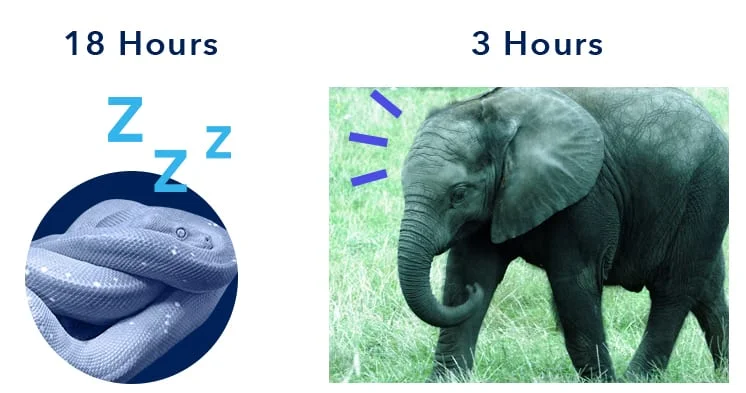
Note: The content on Sleepopolis is meant to be informative in nature, but it shouldn’t take the place of medical advice and supervision from a trained professional. If you feel you may be suffering from any sleep disorder or medical condition, please see your healthcare provider immediately.
FAQ
Q: Which species of animal is the only one to willingly delay sleep? A: Human beings.Why Do Animals Sleep?
Sleep limits the ability to defend against predators and prevents such important activities as mating and the collection of food. For these reasons, researchers theorize that sleep has a crucial evolutionary function.
Decades of studies prove that insufficient sleep has significant health effects such as reduced cognitive function, lowered immunity, increased risk of disease, and death. Sleep may serve to protect some species of animals from predators and other dangers by keeping them inactive during the night when they’re more vulnerable. (2)
Other functions of sleep may include:
- Helping the brain restructure and reorganize, particularly after injury
- Improving the strength and speed of synapses between neurons
- Restoring the capacity to learn
- Increasing long-term memory
Unlike other states of altered consciousness such as coma or hibernation, sleep can be reversed easily. In addition to visual signs such as lying down or finding a protected place to perch, sleep in animals is recognizable by closing of the eyes in those with eyelids, and distinct patterns of brain waves on electroencephalogram (EEG).
One of the defining features of sleep is lowered arousal of the brain. Neurons fire more slowly during sleep, with a more coordinated pattern. (3) Neurons fire more rapidly during REM sleep, the stage of sleep that closely resembles being awake. This may be due in part to the vivid dream activity that occurs during REM sleep.
Electroencephalogram
A test that measures and records electrical activity in the brain.
Why Animals Sleep Differently
The way animals sleep depends on their size, what they eat, and their unique physiology. In general, small animals sleep more than large animals, though they may sleep for only a few minutes at a time. Whales and elephants sleep two to three hours a day. This type of sleep may not occur in uninterrupted blocks of time, but in brief stretches of half an hour or less.
Sleep and Metabolism
Small animals like mice have faster metabolisms, meaning their bodies use energy more quickly than animals with slow metabolisms, like buffalo. The brains of animals with faster metabolisms contain larger numbers of neurons, while the neurons in the brains of larger animals are less dense.

The secret to the way small animals sleep may lie in their brains, which generate more waste by-products called metabolites. (4) Metabolites accumulate during waking hours, while sleep clears them away. Accumulated waste products in the brain can cause smaller animals to fall asleep more frequently. They may even fall asleep while eating or engaged in other activities, and sleep more than twenty hours a day.
In contrast to the brains of bats and shrews, the brains of larger animals generate less waste material. This may explain in part why larger animals sleep less than those that are very small. Some researchers theorize that evolution may favor animals of a larger size by allowing them to consolidate sleep into one longer session, while smaller animals with faster metabolisms need to sleep multiple times in a twenty-four hour period.
FAQ
Q: What is a neuron? A: A specialized cell designed to transmit information to other cells.Sleep, Body Size, and Diet
Another hypothesis about animals and sleep is that larger animals need to eat more to sustain their superior muscle mass. Many very large animals are non-carnivores, and take in relatively few calories in comparison to meat-eaters. Large animals who subsist on grasses and leaves spend less time sleeping than carnivores, and more time foraging for food.
Researchers speculate that the largest land animals in history, dinosaurs, probably slept in similar ways to the largest animals on earth today. Herbivore dinosaurs likely needed less sleep, leaving them more time to forage, while the calorie-dense diet of carnivorous dinosaurs may have allowed for longer stretches of slumber. The biggest animals on earth today, blue whales, spend approximately twenty-two hours awake each day. Similar animals include:
- Elephants
- Giraffes
- Cows
- Rhinoceros
- Giant panda
Larger animals tend to move more slowly than smaller animals, which may help explain their reduced need for sleep. (5) They also experience more time in each stage of sleep. Non-carnivores can devote nineteen hours of their daily wake time to munching on plants and roots.
Sleep and Predators
Smaller animals may be more at risk from predators, making the ability to sleep in shorter snatches of time essential to survival. Being awake, vigilant, and ready to move is important for prey animals, while sleep makes them vulnerable. Sleeping in underground burrows and other hidden areas can also make sleep less dangerous.
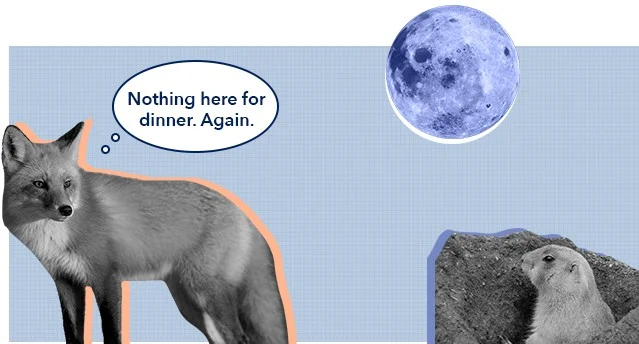
Larger animals have less to fear from natural predators, and can sleep for more consolidated periods of time with less fear. Consolidated sleep allows larger animals to spend less time in transitional states between waking and sleeping, and more time in productive activities such as hunting or mating.
Sleep and Immunity
Scientists have found an association between longer, more consolidated periods of sleep and environments with a greater risk of infection. Because sleep helps to boost immunity, animals who are exposed to more pathogens may have evolved to sleep in consolidated blocks of time so that energy could be directed to the immune system. (6)
Studies show that rabbits who sleep for longer periods of time after infection recover more quickly. (7) Higher densities of disease-fighting white blood cells appear to have evolved along with longer periods of sleep, further bolstering the hypothesis that sleep serves a protective function against parasites, viruses, and bacteria.
Pathogen
Any organism that can cause disease.
Unhemispheric Slow-Wave Sleep
Unhemispheric slow wave sleep, or USWS, is a type of sleep during which one half of the brain remains awake while the other half sleeps. (8) The eye corresponding to the sleeping half of the brain closes while the eye that corresponds to the awake half stays open.
Animals who exhibit USWS include dolphins, some species of birds, and seals. USWS allows dolphins to sleep and surface for air at the same time. Sleeping dolphins swimming on the outside of a group, or pod, will keep the eye that faces the pod open. This eye corresponds with the awake part of the brain. Researchers believe that half-asleep dolphins watch the pod to keep the members of the group swimming together.
USWS may benefit birds by allowing them to remain half awake to protect against predators. USWS can also allow birds to sleep during long flights or migration. Birds flying on the outside of a migrating flock may engage in USWS to watch for predators, while birds on the inside of the flock will sleep with both hemispheres of their brains.
Scientists consider the continuing existence of unhemispheric sleep an example of sleep’s importance. They theorize that if sleep weren’t crucial to survival, evolution would have eliminated it in animals that are able to switch sleep on and off in each half of the brain.
Monophasic, Biphasic, and Polyphasic Sleep
Sleep in animals can take place all at once, in two phases, or more than two phases. Sleeping in one consolidated block of time, known as monophasic sleep, is common in human beings but less common in other species. Monophasic sleep typically lasts between six and nine hours. Less than 14% of animals have sleep patterns that can be considered monophasic.
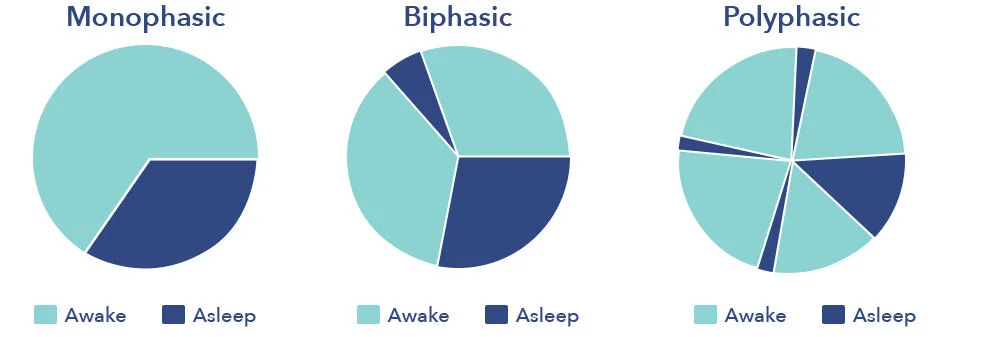
Monophasic sleep was not considered the norm for human beings until the industrial revolution and the extension of labor hours. Before that, biphasic sleep was common across cultures worldwide. Monophasic animals include primates such as the marmoset species of monkey. Marmosets sleep in trees and live in groups of stable families, making them less vulnerable to predators. This may explain why these animals adapted to monophasic sleep, unlike many other species of primates. (9)
Biphasic sleep refers to a larger sleep session lasting five to six hours, plus a nap or siesta. The nap can be brief or last a few hours. Another form of biphasic sleep is called segmented sleep. This refers to two segments of sleep interrupted by an hour or two of wakefulness.
Polyphasic sleep describes sleep that takes place in shorter sessions throughout the day and night. Most animals, including cats, dogs, and birds, are polyphasic sleepers, and sleep in four to six segments per day.
FAQ
Q: Which sleep pattern is most efficient? A: Monophasic, followed by biphasic. Polyphasic is the least efficient, and may lead to sleep deprivation in human beings.When Animals Sleep
Animals evolved to be active during the day, night, or at dawn and/or dusk. (10) When an animal sleeps depends on their environment, feeding habits, and vulnerability to predators. Types of activity behavior include the following:
- Diurnal. Diurnal animals are active during the day and sleep at night. Diurnal animals include human beings, most primates, and many species of birds, including ostriches
- Nocturnal. Nocturnal animals are active and feed at night. Nocturnal animals include raccoons, bats, wolves, skunks, and jaguars
- Crepuscular. Crepuscular animals are most active at dawn and dusk, and include bears, deer, and housecats. Crepuscular animals can also be active on cloudy days and bright nights. Crepuscular activity is likely an adaptation to the behavior of predators, who tend to be most active at night or in full daylight
- Metaturnal, also called cathemeral. The sleep of metaturnal animals is not diurnal, nocturnal, or crepuscular, and is distinguished by sporadic activity at all times of day. Examples of metaturnal animals include lions, some primates, mice, and rabbits. Some animals such as lemurs are considered metaturnal because they switch from diurnal to nocturnal with the seasons. This behavior may become more common as certain species attempt to adapt to climate change (11)
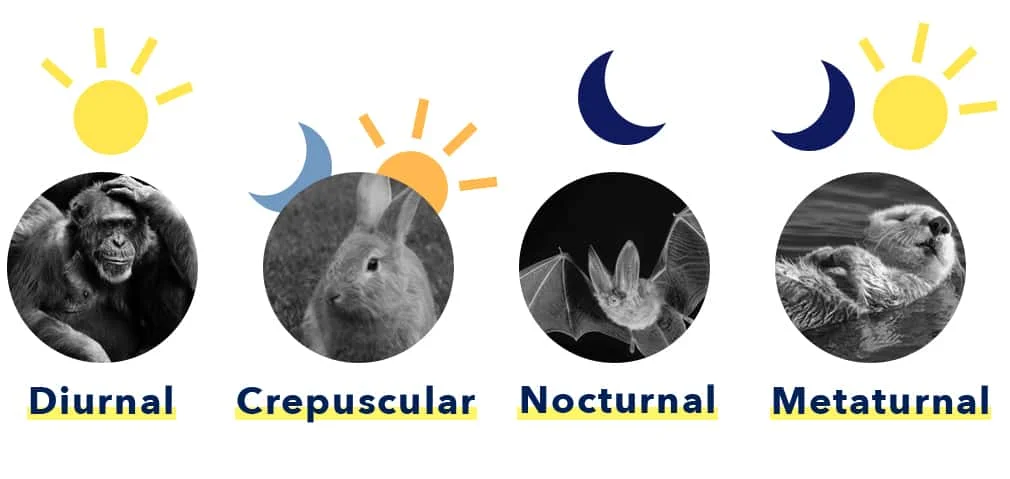 Hibernation Vs. Sleep
Hibernation Vs. Sleep
Some warm-blooded animals hibernate during the winter. A hibernating animal may not move, eat, or sleep for several months. Hibernation might appear similar to an extended sleep, but is quite different. (12) Hibernation is a state of torpor, and is characterized by reduced metabolism, heart rate, and breathing. These vital bodily functions decrease during sleep, as well, but the changes are much more significant during hibernation. Hibernation can last anywhere from days to months.
The most significant feature of hibernation is lower body temperature, which can decrease as much as ninety degrees Fahrenheit. Bears do not technically hibernate because their body temperature drops only minimally, but during the winter months they do experience an extended state of inactivity that closely resembles hibernation.
Cold-blooded animals can enter a hibernation-like state called brumation. This is a period of dormancy that occurs during cold weather. To brumate, a cold-blooded animal such as a snake will find an insulated place to stay during a particularly cold time of year. A hibernation-like state during hot weather is called estivation. Animals that practice estivation include salamanders, bees, and crocodiles.
Both hibernation and estivation allow for the conservation of energy during times of extreme temperatures and food scarcity. Animals coming out of hibernation or other dormant state may display the signs of sleep deprivation when they wake, and spend a few days sleeping while their bodies readjust to the usual environment.
Torpor
A state of reduced physiological activty.
How Mammals Sleep
Mammals are warm-blooded vertebrates who nurse their young and have hair or fur. They aso have a neocortex section of brain and three bones in the middle ear. Despite differences in size and physiology, all mammals share certain aspects of sleep. (13) Animals of this class, from bats that sleep twenty hours a day to horses that sleep four, experience cycles of rapid eye-movement sleep — or REM — alternating with non-REM. REM is the stage when dreaming occurs and the sleeping brain most closely resembles the waking one.
The duration of sleep in mammals ranges from twenty-two hours a day for koalas to no sleep at all during a dolphin’s first month of life. Larger grown mammals may sleep as little as two hours a day, while smaller animals can sleep eighteen hours or more. Mammals such as bats that can hide from predators tend to sleep longer and more deeply than those that need to remain vigilant, like mice.
Though all mammals experience REM sleep, some spend more time in REM than others. Mammals born in a more fully developed state such as horses experience more non-REM sleep than animals who are less developed, like cats and human beings. This supports the theory that REM sleep and dreaming are essential to growth and development in young animals.
Because REM sleep causes muscle paralysis to prevent the acting out of dreams, most mammals must lie down during this stage of sleep, even if it lasts for only a few minutes. Even adult giraffes lie down for REM sleep, curling their long necks in a swan-like position and folding their legs.
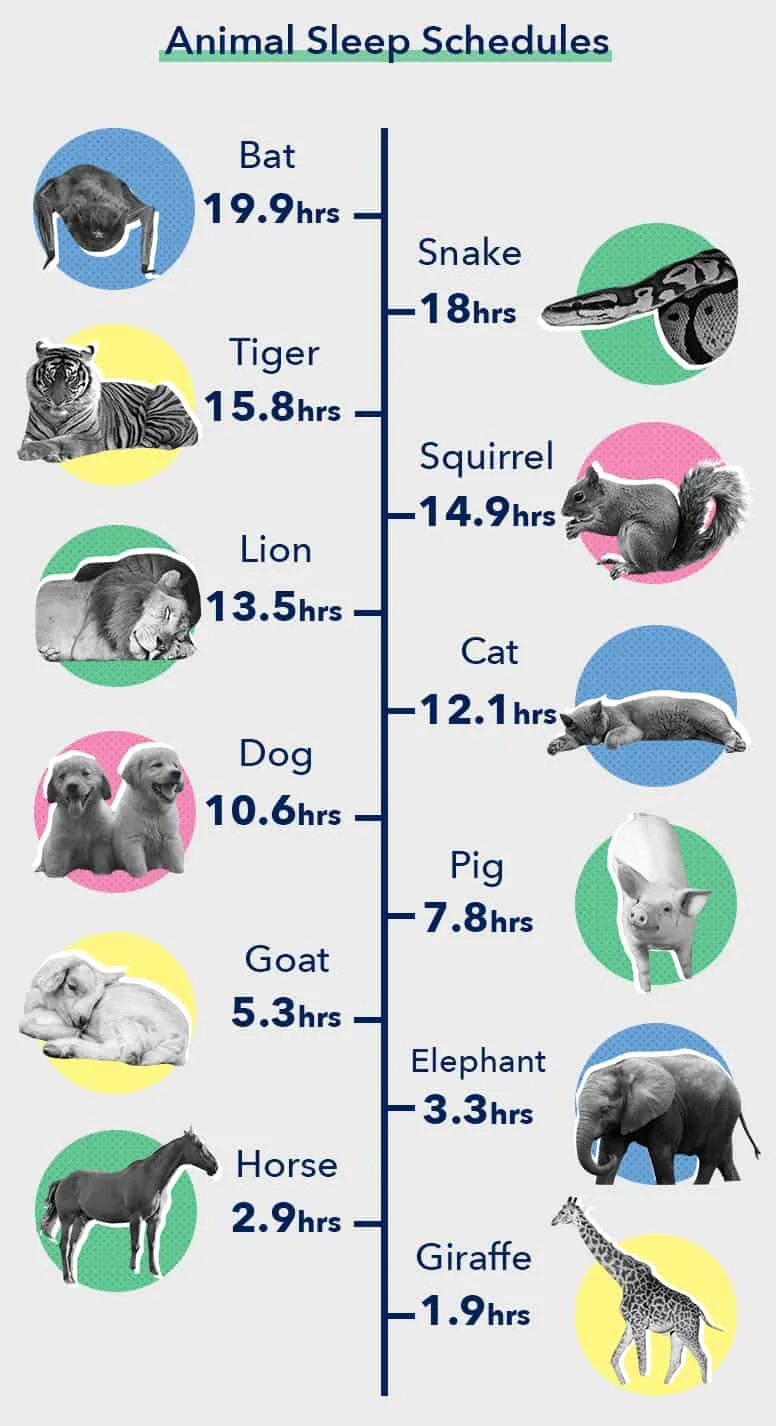
How Reptiles Sleep
Researchers once believed that reptiles slept very differently from other animals due to the structure of their brains. But recent studies have found that reptiles display similar sleep patterns to human beings and other mammals. (14) These patterns include slow wave sleep and REM sleep, suggesting that reptiles dream to process and store memories. Reptile REM sleep originates in parts of the brain other than the hippocampus, which controls REM sleep in mammals.
Other research shows possible evolutionary connections between the way reptiles rest and bask in warmth and the sleep of mammals. (15) In fact, all waking and sleeping states in mammals might have come from reptiles, who evolved much earlier than mammals and birds. The starkest difference in the sleep patterns of reptiles and mammals may lie in the length of their sleep cycles. (16) A reptilian sleep cycle lasts only eighty seconds compared with mammalian cycles, which typically last ninety minutes. Though the sleep cycle is significantly shorter, the proportion of REM sleep to non-REM remains the same in reptiles as it does in human beings and other animals.
Most reptiles sleep around sixteen to seventeen hours a day, and may go into a state of brumation during particularly cold times of year. Some reptiles, like snakes and lizards, don’t have eyelids to close when they sleep. Instead they have a protective scale called a brille that slides across their eyes. The brille is transparent or only slightly opaque, making it appear as if these animals sleep with their eyes open.
FAQ
Q: What is the origin of the word brumation? A: Brumation was first coined in the mid-60’s by zoologist Wilbur Mayhew. It’s a combination of the Latin word bruma, meaning winter solstice, and nation, from hibernation.How Birds Sleep
Birds evolved from dinosaurs, which evolved from early reptiles. Mammals branched off from reptiles before the evolution of the dinosaurs. Birds experience both REM and non-REM sleep, and, depending on the type of bird, may be diurnal, nocturnal, metaturnal, or crepuscular. Like reptiles, the sleep cycles of birds are much shorter than those of human beings. They may spend only eight seconds in REM sleep before shifting to slow wave sleep.
Some birds perch on the edge of a branch or other object to rest, whereas others sleep on the ground, hidden among leaves, or at the water’s edge. Birds are able to remain perched while asleep because their body weight causes the tendons in their feet to lock, preventing them from falling.
Birds sleep while flying during long migrations by utilizing their capacity for unhemispheric sleep. By opening or closing its eye, a bird can control how much of its brain is asleep. Some types of birds, such as the alpine swift, can fly for seven months at a time without landing. (17) They are able to drink, eat, and sleep while in flight, and rest by both sleeping and gliding with minimal flapping of their wings.
Though many animals exhibit signs of sleep deprivation like engaging in longer and deeper periods of sleep after extended activity, alpine swifts are able to completely recover from activity by sleeping in flight. This suggests that some birds are able to perform all physiological functions while in flight, including resting and sleeping.
REM sleep
The last of the four stages of sleep, characterized by rapid movement of the eyes, dreaming, and muscle paralysis. The brain is almost as active during REM sleep as it is during wakefulness.
How Fish Sleep
Brain patterns of certain types of sleeping fish are similar to land animals, raising the possibility that sleep functions developed in the brain before fish and land animals took different evolutionary paths. (18) Studies show that, like reptiles, mammals, and birds, fish experience slow-wave sleep and REM sleep. Signals from hormones control the sleep and wake cycles of fish, just as they do in mammals.
Fish have no eyelids and are unable to close their eyes. Like mammals and other animals, when fish sleep their vital signs such as heartbeat and breathing decrease. They remain still and relaxed, their tails drop, and they don’t react to stimuli. The movements of their mouths and gills can decrease by half. Some fish simply float when they sleep, while others hide in rocks, nests, or coral.
Normal sleep patterns can take weeks to develop in young fish. (19) Some fish are able to go without sleep when constant activity is required, such as during spawning season or while fanning eggs to keep them oxygenated. Fish may also forego sleep during migration. Once these periods of high activity are over, the fish return to their normal sleep patterns, and can display symptoms of sleep deprivation until they “catch up” on sleep.
Some types of sharks need to stay in continual motion to keep water flowing across their gills and providing a steady supply of oxygen. Whereas some sharks do appear to sleep, sharks in constant motion may simply experience more restful periods when brain activity decreases and memories are formed. A shark may have limited memories to store due to its repetitive environment, decreasing its need for sleep.
A shark’s spinal column regulates its movements as it swims, which may allow the brain to sleep while the body stays in motion. Further research is needed to help us understand how sharks sleep, and if they experience similar stages of sleep to other fish.
FAQ
Q: Do jellyfish sleep? A: Yes. Even though they don’t have a brain, jellyfish experience a daily rest period that resembles and functions like sleep.Do Animals Dream?
Researchers believe it’s likely that animals who experience REM sleep also dream. REM sleep is associated with processing and storing memories, and may be essential to learning and survival. Studies on human beings show that REM sleep is also important for processing emotions, and can reduce negative emotions and reactivity. REM sleep may serve a similar function in more emotionally developed animals, such as dogs, primates, and dolphins.
Studies reveal that rats and human beings share similar brain activity during sleep. Neurons in the brains of rats rewarded with food will fire in a distintive pattern. This pattern will replay during rest, suggesting the formation of memories. (20)
Research conducted on cats in the 1950’s demonstrated that, without the muscle paralysis characteristic of REM sleep, cats go through motions suggestive of dreaming, including stalking prey and pouncing. REM sleep appears to have a crucial survival function, allowing animals of all species to discard unnecessary memories, store important ones, and use past experiences to better adapt to their environments.
Do Animals Suffer From Insomnia?
Animals exposed to a stressful environment can display the symptoms of insomnia. (21) Studies show that insomnia in animals, like human beings, may occur for the following reasons:
- Disruption of the circadian rhythm
- Activation of the central nervous system, including wake-promoting regions of the brain
- Release of stress hormones
- Disturbance of the homeostatic regulation of sleep, or the sleep drive
When exposed to stressful conditions, animals seem to have difficulty sleeping just as human insomniacs do. Studies on animals are generally conducted in laboratories, zoos, and other unnatural environments, making it difficult to determine why insomnia may occur in certain species.
Fruit flies bred in the laboratory can suffer from the symptoms of insomnia, including difficulty falling asleep and staying asleep. It’s unknown if flies not specifically bred for research purposes would suffer from insomnia in their natural environment. Zebrafish with a particular mutant gene will experience insomnia, sleeping 30% less than fish of the same species without the gene. Overexpression of a gene called Nmu, also found in mammals, appears to be the cause of the behavior. Studies of these fish, who have similar sleep patterns to human beings, may help lead to better insomnia treatments and more effective sleep medications.
Zebrafish
A freshwater fish that belongs to the minnow family and is native to South Asia.
Animals and Other Sleep Disorders
Domestic animals can suffer from other sleep disorders common in human beings, such as bedwetting and sleepwalking. Further studies are needed to determine whether these disorders occur in animals in the wild. Dogs, cats, and horses may also display symptoms of narcolepsy, an autoimmune disease characterized by excessive sleepiness and sudden “sleep attacks.” Muscle weakness is another common feature of the disorder. Narcolepsy in animals can be caused by a genetic mutation or occur without an apparent cause.
Last Word From Sleepopolis
Sleep is essential to life for all animals, from a two-inch pygmy shrew to an eighteen-foot giraffe. The characteristics of sleep vary widely across species, and depend largely on metabolism, the existence of predators, and feeding habits.
Sleep can look very different, even among animals of the same class. Mammals like dolphins sleep with half of their brains at a time for only a few hours each day, whereas koalas sleep with both hemispheres of the brain for around twenty-two hours a day. This diversity illustrates the fascinating variations in sleep among animal species, and its crucial importance to the health and wellbeing of all living things.
References
- Miyazaki S, Liu CY, Hayashi Y., Sleep in vertebrate and invertebrate animals, and insights into the function and evolution of sleep, Neuroscience Research, May, 2017
- Siegel JM., Sleep viewed as a state of adaptive inactivity, Nature Reviews, Neuroscience, October 2009
- Schwartz JR, Roth T, Neurophysiology of Sleep and Wakefulness: Basic Science and Clinical Implications, Current Neuropharmacology, December 2008
- Lulu Xie et al., Sleep Drives Metabolite Clearance from the Adult Brain, Science, October 18, 2013
- Patrick J.O. Miller, Stereotypical Resting Behavior of the Sperm Whale, Current Biology, January, 2008
- Preston BT, Capellini I, McNamara P, Barton RA, Nunn CL, Parasite resistance and the adaptive significance of sleep, BMC Evolutionary Biology, January 9, 2009
- Toth LA, Tolley EA, Krueger JM., Sleep as a prognostic indicator during infectious disease in rabbits, Proceedings of the Society for Experimental Biology and Medicine, June 1993
- Gian Gastone Mascetti, Unihemispheric sleep and asymmetrical sleep: behavioral, neurophysiological, and functional perspectives, Nature and Science of Sleep, July 12, 2016
- Ishikawa A, Sakai K, Maki T, Mizuno Y, Niimi K, Oda Y, Takahashi E, Investigation of sleep–wake rhythm in non-human primates without restraint during data collection, Experimental Animals, October 18, 2016
- Kronfeld-Schor N, Bloch G, Schwartz WJ., Animal clocks: when science meets nature, Proceedings of the Royal Society B, Biology Sciences, August 22, 2013
- Levy Ofir, Time and ecological resilience: can diurnal animals compensate for climate change by shifting to nocturnal activity? Ecological Monographs, November 12, 2018
- Kathrin H. Dausmann et al., Hibernation in a tropical primate, Nature, June 24, 2004
- Tobler I., Is sleep fundamentally different between mammalian species? Behavioural Brain Research, July-August 1995
- Libourel PA, Barrillot B, Arthaud S, Massot B, Morel AL, Beuf O, Herrel A, Luppi PH., Partial homologies between sleep states in lizards, mammals, and birds suggest a complex evolution of sleep states in amniotes, PLoS Biology, October 2018
- Ruben V. Vial et al., Evolution of wakefulness, sleep and hibernation: From reptiles to mammals, Neuroscience & Biobehavioral Reviews, July 2010
- Mark Shein-Idelson, Slow waves, sharp waves, ripples, and REM in sleeping dragons, Science, April 29, 2016
- Felix Liechti, First evidence of a 200-day non-stop flight in a bird, Nature Communications, October 2013
- Louis C. Leung, Neural signatures of sleep in zebrafish, Nature, July 10, 2019
- Shapiro CM, Hepburn HR., Sleep in a schooling fish, Tilapia mossambica, Physiology and Behavior, May 1976
- H Freyja Ólafsdóttir, Hippocampal place cells construct reward related sequences through unexplored space, eLIFE, June 26, 2015
- Toth LA, Bhargava P., Animal Models of Sleep Disorders, Comparative Medicine, April 2013

























